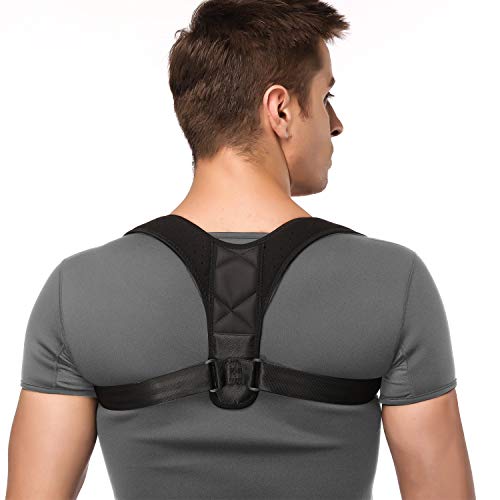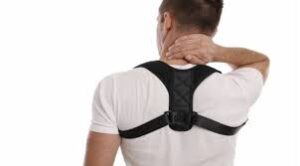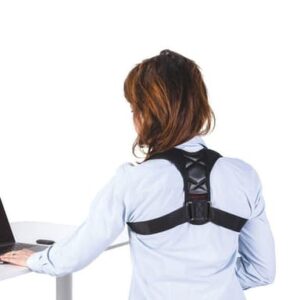

A posture correction strap is not a magical fix but a tool that can guide your body toward better alignment when used correctly.
It is especially helpful for people who sit at desks for long hours, perform repetitive tasks, or tend to slouch unconsciously. The key is to integrate it into your day-to-day life through intentional steps.
This guide by Best Forward Head Posture Fix breaks down exactly how to use a posture correction strap during your routine activities—no fluff, no distractions—just actionable strategies backed by science and user-tested methods.
Each step is designed to progressively improve your posture while avoiding dependency on the device.
Whether you are walking, sitting, or performing chores, there is a way to make the strap work for you.
Let us get started with the first and most critical step.
Points Covered in this Article:
- Choose the Right Strap
- Adjust the Fit Correctly
- Start with Short Wear Periods
- Use It While Sitting at a Desk
- Use It During Standing or Walking Tasks
- Activate Your Core Muscles with the Strap
- Don’t Wear It All Day
- Increase Duration Gradually
- Wear It During Light Movement
- Remove and Check Posture After Each Session
- FAQs on Posture Correction Strap for Text Neck Correction
- Conclusion
Choose the Right Strap
Before you even put on a posture correction strap, you need to make sure you’ve chosen the right one.
Not all straps are created equal—some are rigid, some flexible, and some designed for specific areas like the upper back or lumbar spine.
Look for a model made of breathable, lightweight material that would not irritate your skin or trap sweat. It should feature adjustable straps so it can be customized to your body type.
If you work at a desk, consider straps with shoulder blade stabilization. If you are more active, go for a strap that allows full range of motion.
Always read user reviews and check for sizing guides before purchasing.
Medical-grade options may be best if you have preexisting spine conditions. Remember, the right strap should support, not immobilize, your posture.
A poorly fitted strap will either do nothing or cause discomfort. This is the foundation step—get it right.
Adjust the Fit Correctly
Proper fitting is essential for the posture strap to do its job. Begin by putting it on over a light shirt or breathable fabric.
Fasten all velcro or clips securely, then tighten the straps until your shoulders are gently drawn back. You should feel your chest open slightly and your shoulder blades move closer together.
However, it should not feel overly restrictive—you must still be able to move your arms and rotate your torso freely.
The back of the strap should sit level with your mid-back and not ride up over your shoulders or dig into your neck. If the strap has a lower lumbar band, ensure it rests snugly above your hips and not on your waistline.
Re-adjust if you feel pinching, strain, or numbness. It is helpful to use a mirror to check alignment when putting it on. Remember, comfort and alignment are equally important here.
Start with Short Wear Periods
Don’t make the rookie mistake of wearing your new posture strap all day on the first go. Your muscles are likely weak or imbalanced, so introducing a support device too aggressively can lead to overcorrection or soreness.
Begin by wearing it for 10 to 15 minutes on your first day. During this time, perform light tasks like standing, walking around, or stretching. Monitor how your shoulders, upper back, and neck feel during and after use.
You may notice some mild discomfort, which is normal, but sharp pain is a red flag.
Slowly increase the wear time by 5-minute increments each day based on your comfort level. This short acclimation period helps your body adjust to the sensation of alignment cues without developing reliance.
Think of the strap as training wheels for your posture. In these early days, your focus should be on building awareness, not endurance.
Use It While Sitting at a Desk
Most people develop poor posture while seated—especially during long work hours. Use your posture strap when you’re at a desk to combat this slump.
Sit with your feet flat on the floor, knees at a 90-degree angle, and shoulders relaxed. After putting on the strap, ensure your spine is in a neutral position—not overly arched or rounded.
The strap should cue your shoulder blades to retract slightly, keeping your upper back engaged and chest open.
Pair this setup with an ergonomic chair that supports your lumbar spine and encourages upright seating. Avoid crossing your legs or hunching forward toward the screen. If you are typing, make sure your wrists are level and your elbows form a right angle.
Take posture breaks every 30 minutes: stand up, roll your shoulders back, and recheck your alignment. This reinforces muscle memory while making the most of your posture strap.
Use It During Standing or Walking Tasks
Standing and walking with a posture strap helps reinforce upright alignment when you are on the move. Wear the strap during simple errands, short walks, or when you are in queues.
As you walk, keep your chin slightly tucked and your shoulders relaxed. The strap will act as a reminder to avoid forward head posture and rounded shoulders.
You would find your scapular muscles subtly engaging with every step. Let your arms swing naturally—if they feel restricted, loosen the strap slightly.
Wearing the strap in this way not only improves posture but also trains your body to default to proper alignment even after the strap is removed.
It is especially effective during activities like grocery shopping, walking the dog, or cleaning, where posture often deteriorates without you noticing.
These short, active sessions are a great way to build endurance in your upper-back muscles while integrating posture correction into real-life scenarios.
Activate Your Core Muscles with the Strap
Using a posture strap does not mean you can ignore your core—on the contrary, the two should work together.
Every time you wear the strap, take a moment to engage your abdominal muscles. Think of gently drawing your belly button toward your spine without holding your breath.
This helps stabilize your spine and maintain an upright posture from the base upward. The strap supports the upper body, while your core supports your midsection and pelvis.
This co-activation builds a full-body awareness of posture, which is critical for long-term correction. Avoid clenching or tensing your core—aim for a light, sustained contraction that you can hold while breathing normally.
Whether you are sitting, standing, or walking, pairing the strap with core engagement ensures you are training multiple muscle groups involved in posture.
Over time, this coordination becomes second nature, and your body will naturally adopt a more aligned, efficient stance even without the strap.
Do Not Wear It All Day
Posture correction straps are training tools—not permanent fixtures. Wearing one all day can lead to muscle atrophy because your back muscles stop working as hard when external support is constantly provided.
The general rule is to wear it no more than 2 to 4 hours per day. Begin with shorter sessions and allow ample time in between to move freely without the strap.
If you feel you cannot maintain proper posture without the strap, it is a sign your wear time has been too long or you need to strengthen your postural muscles.
Use breaks as opportunities to reinforce good posture on your own, checking your alignment in mirrors or using self-correction cues like thoracic extensions on a bench.
The goal is gradual independence from the device. If you use the strap wisely and sparingly chances of your c2 vertebrae out of alignment are high. So, it becomes a teacher—not a crutch. Quality of wear is far more important than duration.
Increase Duration Gradually
Once your body adapts to short use periods, you can begin to wear the strap for longer durations—always within safe limits.
Gradually build up your wear time by 15-minute increments every 2–3 days, monitoring how your muscles feel afterward. By the end of two weeks, you may be able to comfortably wear the strap for 1–2 hours at a time.
However, this does not mean longer is better. Your main indicator of success is not wear time—it is posture improvement without the strap.
Use your phone or a mirror to record your posture after removing the device. If your alignment holds, you are on the right path. During extended wear, make sure you are moving and not remaining static.
Stretch your trapezius periodically, breathe deeply, and vary your activities. This slow and steady approach ensures your muscles adapt to the posture cues without developing passive dependency on the strap.
Wear It During Light Movement
The posture correction strap is not just for sitting—it works well during light physical activity. Doing housework, walking up stairs, gardening, or organizing shelves are ideal moments to wear it.
These tasks challenge your posture in dynamic ways, and the strap can guide your muscles toward alignment during movement.
Be mindful, though—avoid high-impact exercise or heavy lifting while wearing the strap, as it may restrict range of motion or cause discomfort.
Keep your movements smooth and controlled, and use the strap to feel how your shoulder blades should stay retracted during activity.
This type of kinesthetic learning is invaluable—it helps your body remember what “good posture” feels like when you are moving through space.
Wearing it during light chores makes posture correction feel less like a chore and more like a built-in part of your lifestyle. That is when the real transformation begins to happen. Cervical collars reduce neck strain thereby helping you feel better.
Remove and Check Posture After Each Session
After each session with the strap, it is critical to check your natural posture. Stand in front of a mirror and remove the strap slowly.
Relax your shoulders and arms, then roll your shoulders back and let them settle. Look at your spine, shoulder level, and head position.
Do you maintain upright posture, or do you slump immediately?
If you revert quickly, reduce your wear time or focus more on strengthening exercises. If you stay relatively aligned, you are making progress.
Taking a “before and after” picture once a week can also help you visually track improvement. This debrief is more than just a final step—it is a key feedback loop. It helps you recalibrate strap usage and guides your next session.
By regularly checking your alignment after removal, you reinforce the neural and muscular connections necessary for long-term posture correction.
FAQs on Posture Correction Strap for Text Neck Correction
Q-1: How tight should a posture strap be, and how do I set the tension correctly?
A-1: Aim for gentle retraction, not immobilization. Tighten until your shoulders naturally settle back and your breastbone lifts slightly, then back off one notch so you can take a deep breath without resistance. You should feel it cueing—not squeezing. If skin marks last longer than 15 minutes or you feel tingling, loosen immediately and reassess fit.
Q-2: What’s a safe break-in schedule for daily life (desk, errands, light chores)?
A-2: Start with 20–30 minutes per day for the first 3 days, then add 10–15 minutes every other day up to 2 hours total. Use it during activities that tempt slouching—email, scrolling, meetings—not all day. The goal is habit training, not brace dependence. Take 5-minute “strap off” movement breaks each hour to reset circulation and shoulder mobility.
Q-3: How do I combine the strap with computer work so my neck doesn’t drift forward?
A-3: Put the strap on after you’ve set your workstation: top of screen at or just below eye level, keyboard close, feet flat. Once seated, do a quick cue: “rib cage stacked, chin gently tucked.” If the strap pulls your shoulders back but your head still cranes, raise the monitor or increase text size. Recheck strap tension whenever you change chair height or desk position.
Q-4: Can I wear the strap while walking, driving, or doing light workouts?
A-4: Yes for walking and light household tasks; it’s useful for reinforcing upright carriage. For driving, keep tension light so it doesn’t limit checking mirrors or shoulder turns. For workouts, avoid it during lifts or overhead motions—use it only in warm-ups to groove scapular setting (e.g., 5 breaths + 10 band pull-aparts), then remove to train your own stabilizers.
Q-5: What shoulder and neck exercises pair best so I don’t become dependent on the strap?
A-5: Do 2–3 “strap off” sets daily:
Scapular retractions (squeeze shoulder blades down/back): 2×12
Chin tucks against a wall: 2×8 (3-second holds)
Band pull-aparts or W-raises: 2×12
Pec doorway stretch: 2×30 seconds
This strengthens mid-back and deep neck flexors while lengthening tight chest tissues, making the strap a reminder, not a crutch.
Q-6: How do I track progress and when should I taper?
A-6: Take a side photo on day 1 (ear-shoulder-hip alignment) and again every 2 weeks. Note comfort during a 30-minute sit and whether end-of-day neck tightness decreases. When posture holds during two consecutive 60-minute desk blocks without the strap, cut use to cue-only moments (meetings, long calls). If pain, numbness, skin irritation, or breathing restriction occurs, stop and consult a clinician.
What You Takeaway from this Write-up?
A posture correction strap can be an excellent tool for daily posture improvement—when used correctly.
It is not about wearing it longer or tighter, but about wearing it smarter.
Begin with a good fit, use it during relevant tasks like sitting, walking, and chores, and always combine it with core activation.
Avoid overuse, increase wear time slowly, and constantly reassess your natural alignment after each session.
The key takeaway?
The strap should cue your body—not control it.
When you follow these structured steps consistently, you would train your muscles and mind to adopt good posture naturally.
This habit-building approach offers a lasting solution to poor alignment, rather than a temporary fix.
References:

